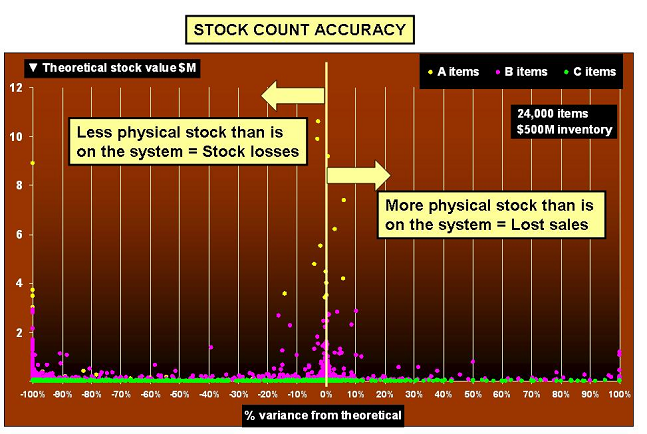|
Any distributor making replenishment calculations needs an accurate electronic inventory reference because, simply put, the electronic system data is the theoretical balance in stock and it is the basis of determining stock availability. Depending on where you sit, there are two somewhat contrasting points of view concerning inventory accuracy.
First, from a financial reporting standpoint, a low average stock variance is desirable. However, a low AVERAGE stock variance can also imply that there are significant offsetting positive and negative variances within individual SKUs. In fact there can be huge individual variances at the SKU level and an “acceptable” overall variance result (for the purposes of financial reporting).

Second, from an operations standpoint, we want to have stock variances within individual SKUs at very low levels to ensure high quality in customer service. Negative SKU variances mean there are stock losses, while positive SKU variances mean that physical stock exists that there is no record of, and therefore may be unsaleable. Third, we want a “clean” theoretical electronic stock balance that reflects only saleable inventory for sales order / inventory allocation transactions to be performed against.
Separating Saleable From Unsaleable Inventory
From an operating standpoint, separating the inventory into saleable/unsaleable classifications is both an electronic transaction and a physical transaction. Many software packages accomplish this electronic separation by using codes that make the inventory unavailable to order takers and buyers. Where the software does not have this feature, a common approach to create electronic separation such as “virtual” or electronic warehouses where unsaleable items are transferred into. Irrespective of the method used, the electronic separation should be accompanied by some physical relocation or identification system so that product is not selected/ counted by mistake as saleable inventory. From the perspective of financial reporting the overall inventory position remains the same, because the balances in all electronic warehouses are added for a total inventory position.
The electronic separation of inventory does not only handle products on hold, damaged products and obsolete products. It also can incorporate areas that require further investigation, such as cycle count variances, before the balances are written off. A word of caution though - a virtual warehouse can grow to house huge values of inventory if it is not regularly “cleaned”.
Physical Counting
If all electronic transactions were 100% accurate, and all physical inventory movements were accurately recorded electronically, there would never be a need for the physical counting of stock. Stock positions would always equal the theoretical electronic balances. Unfortunately, the real world requires physical verification of what is being reported as a theoretical balance. Quarterly or annual physical counts are generally inadequate for maintaining accurate inventory balances, because if there are problems, they are only recognized when the counts occur. A physical cycle counting program is critical to ensure early identification of inventory problems. One cycle counting methodology that is commonly used is to classify items into ABC categories, with higher count frequencies (e.g. daily/weekly) for higher value A items than for lower value C items. In addition, there exist at least four other cycle counting methodologies that are supported by most leading warehouse management systems.
Similar to scheduled quarterly/annual physical counts, systematic cycle counts need to be compared to the theoretical system balances to determine stock variance levels. In the absence of a real time warehouse management system, the reconciliation of cycle count variances may be difficult if cycle counting is performed while other warehouse transactions are being performed at the same time. This is why cycle counts are generally conducted during low activity periods, often at night or before commencing operations. Note that even this safeguard may not be sufficient for the effective reconciliation of variances. Rules must also be put in place so that any outstanding paperwork affecting theoretical inventory balances must be processed accurately prior to commencing the cycle counting program. If this is not done, a great deal of time can be wasted finding that a disturbing variance was in fact simply an unprocessed document on someone’s desk, or the inaccurate processing of a given document.
Conducting a cycle counting program is difficult without (1) a real time inventory system and (2) a product location system that tracks the quantity of product in each bin location. When a product is not explicitly located in a bin location, it has to be found by memory or by direct sight. If multiple products of similar type are commingled together in the same bin location, it may be possible to find items easily, but when there are large numbers of SKUs in a large facility, the likelihood of locating all of the SKUs physically becomes more difficult and time consuming. Of course, not finding all of the physical products subsequently generates cycle count variances.
Cycle counting is an early warning mechanism for multiple operating problems:
- When SKUs show a growing negative variance trend from repeated counts, it may indicate that theft is occurring. In this case immediate focused action can be taken on the SKUs in question, either with additional checking of transactions involving the product, or by moving these items into areas of higher security.
- Oscillating variances can indicate inaccurate document processing in both receipt and delivery activities.
- Consistent count overages are almost certain to suffer reversals at some future point, and can indicate inaccurate document processing in both receipt and delivery activities.
Critical Control Areas That Drive Variances
Controlling theft is an area of primary importance in any facility that stocks physical inventory. Cycle counting, as an early warning system, is a fundamental tool to deterring theft. But cycle counting is an “after the fact” control (since it catches the variance after it has occurred), and also does not address the actual theft problem:
- The number one risk area where inventory can be lost AND where variances are difficult to resolve is through collusive activities by receipt, or delivery personnel. On the receipt side, a vendor’s shipment of goods can be diverted to an undisclosed location. If the receipt staff processes the vendor documents as having been physically received in full, cycle counting will later identify the variance, but the problem will take a long time to resolve because it will be assumed, first, that all receiving documentation is correct. The vendor will have been paid - with receipts verified by receipt personnel - so there will be no complaints from the supplier. On the other hand, if receiving personnel do not process the receiving documents, then vendor complaints about nonpayment will quickly draw attention to a trail of, first, the truck operator, and then anyone else who was associated with the inbound shipment. However, the company can take a “hands-off” approach in this situation, making the point to the vendor that the goods were never delivered to the DC, and it is therefore not the company’s problem. If the truck is an independent operator and not owned by the company then there will be grounds for this position. In this latter case, cycle counting will NOT pick up the discrepancy.
- On the delivery side, more goods can be put on outbound shipments than the documents indicate. Cycle counting will pick up this variance, but its source will be difficult to pin down because it will be assumed, first, that all order picking and shipping documentation is correct. Another type of situation occurs when goods are shipped in the documented quantities, but they are actually delivered to an undisclosed location. The “proof of delivery” documents are then returned with forged signatures. Distributors servicing thousands of customer accounts do not keep track of authorized signatures of customers, so this type of forgery is easy to slip into the system. If the truck is a 3rd party operator then he is paid based on proof of delivery. It is not until the customer sees the monthly statement that a problem may be identified. Sometimes the customer simply assumes an error on the part of the company and pays the statement less what was actually received, which will prompt queries from the company months later.
- In operations where there is simultaneous receiving, putaway, order selection, loading, and replenishment activities taking place on the same shift, stock control can be difficult. This is particularly true in locations where infrastructure is not configured to allow a good physical separation of activities. The causes of variances are difficult to trace here because of the high risks of this type of operation (e.g. inbound product could be diverted to delivery trucks before being checked off as being received). When infrastructure does not permit easy physical separation of activities, continuous operations should be decoupled from each other to increase stock control. This can be done by either performing activities at different times, or by having process changes made. For example, a straight order picking and truck loading operation may be modified so that a staging area is instituted between picking and loading, effectively adding a control point to the process, without necessarily reducing delivery cycle times.
- Heavily overstocking a DC to avoid the costs of extra external outside storage warehouse costs may be a false saving. Not only does it affect the ability to flow product for day to day receiving and delivery operations, but it may also result in increased damages and a general inability to count stock effectively on a continuous basis. This defeats the effectiveness of cycle counting as a control tool, and therefore any variances do not get noticed for long periods of time. It is generally always better to maintain product accessibility and flow in the DC and to use reserve warehouses to store excess inventory.
- Although moving assembled unit loads (pallets of product), through inbound and outbound processes is more efficient than moving the product one case at a time, care should be taken to ensure that there is no missing product within the center of the pallet, with its absence hidden by a carefully packed perimeter of product. These types of variances are generally not picked up in cycle counts, and only become noticeable during order picking, when a pallet is broken down, or at delivery (either by the truck operator when he loads a truck on a case by case basis, or by the customer when checks off receipts).
Marc Wulfraat is the President of MWPVL International Inc. He can be reached at +(1) (514) 482-3572 x 100 or by clicking here. MWPVL International provides supply chain, logistics distribution consulting services including purchasing and inventory management. Our services include: distribution network strategy; distribution center design; material handling and automation design; supply chain technology consulting; product sourcing; 3PL Outsourcing; and purchasing; transportation consulting; and operational assessments.

|